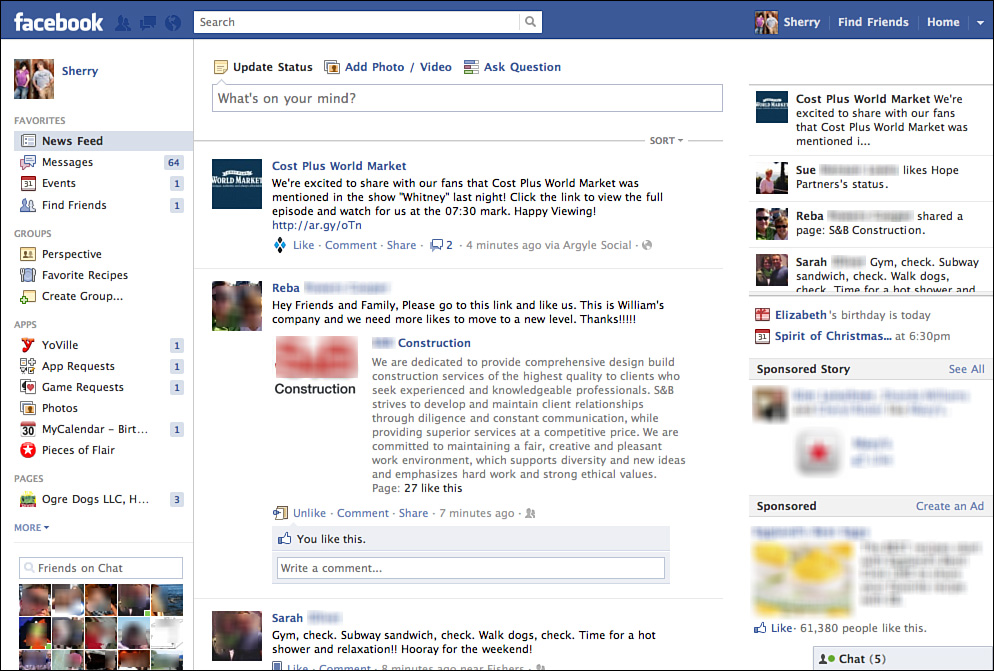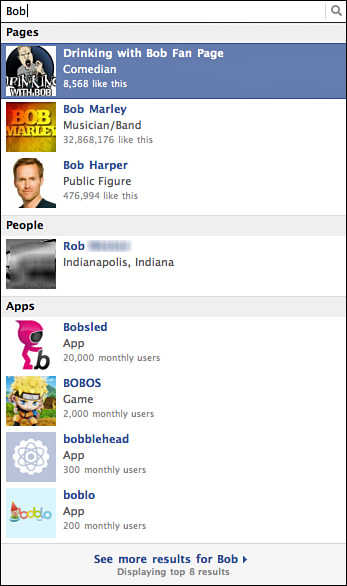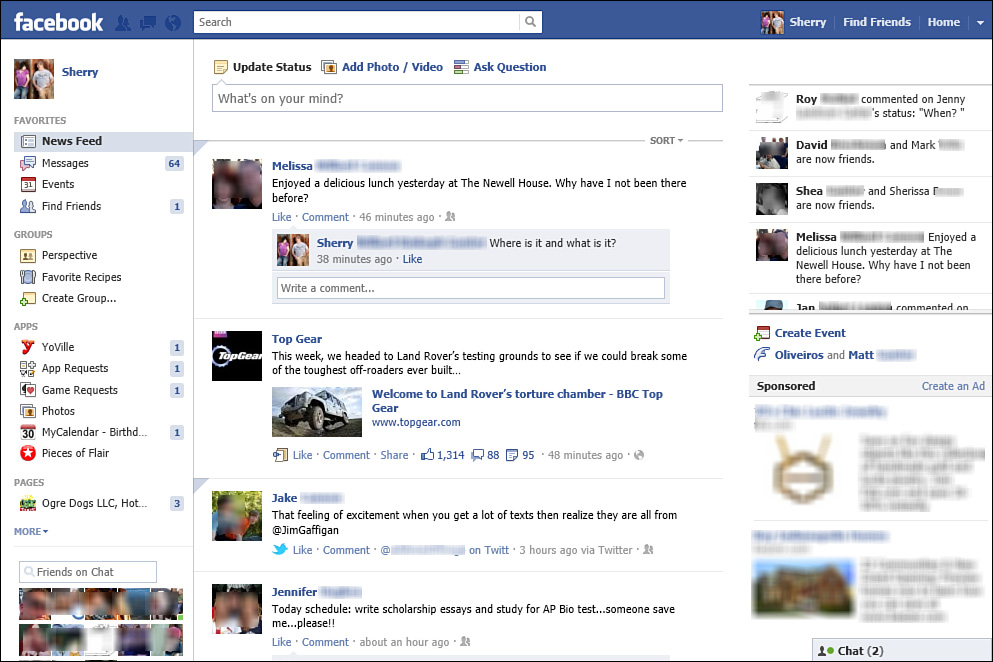Lesson 5. Navigating the Home Page
In this lesson, you learn how to keep track of news and activities on Facebook. You’ll learn how information flows on the site, and how to use the Home page to view the news feed and notifications to keep abreast of the latest information.
Understanding Facebook Information Flow
As a social networking site, Facebook acts much like a broadcasting service, sharing news about its members wherever they are. However, rather than tuning in to see general news about everyone on the site or stories selected entirely by Facebook, your news is narrowed down to just the people you know—your friends, family, coworkers, or colleagues. The news that is shared—whether it’s status updates, photos, or the latest link someone posted—is referred to as stories on Facebook. This news is also called feed stories, stream, or news feed stories. The information that appears on the Home page is a constant stream of stories about the activities and pursuits of your friends. The official name for this is news feed, so that’s what we’ll call it, too. The stories that appear on your profile’s timeline are mini-feeds because they’re all about you.
For example, anytime you post a status update on your profile page, it’s a story on your timeline—mini-feed information dedicated to you. When your friend shares a photo, it appears on his timeline as a mini-feed about him. Out on the Home page, both stories may appear listed as news feed stories where other friends you both know can see them.
What exactly constitutes as news on Facebook, you may wonder? Anything you do on the site is considered a story. If you comment on someone’s timeline, for example, or share a link, it appears as an activity, and potentially listed in the main news feed. If you don’t want to share all your Facebook activities, you can turn off some of this through your privacy settings. (See Lesson 7, “Guarding Your Privacy,” to learn more.)
Another part of this ongoing stream of broadcasting is a Facebook feature called notifications. Notifications are messages from Facebook telling you about something that happened on Facebook involving you somehow, such as being tagged (pointed out) in a photo or if someone wrote on your wall. Typically, these notifications are emailed to you or sent via your mobile connection. On Facebook, they appear on the Notifications pop-up list or in the left pane of the Home page. Unlike mini-feeds that are generated by you, or news feeds that detail the activities of others, notifications involve you indirectly.
Let’s get down to the nitty-gritty details of how to navigate and work with info on the Home page.
Understanding the Home Page
The Home page is where all the Facebook action takes place outside of your profile page. To view the Home page, click Home on the navigation bar (the blue bar at the top of any Facebook page). A page similar to Figure 5.1 appears. Not only do you see a news feed of recent items, the page also includes links to other features, both on the left and right panes of the page, plus some discreet advertising and a visual listing of who’s online.
Figure 5.1 Here’s a typical Home page, showing a news feed in the middle, shortcut links along the left pane, and advertising along the right pane.
Top and center on the Home page is another status update box, labeled Update Status. This is the same box you use to post status updates to your profile page. (This is just another way of sharing your activity on Facebook without having to redisplay your profile page. To learn more about posting a status update, see Lesson 4, “Navigating Your Timeline.”)
Using the Navigation Bar
The navigation bar appears at the top of every Facebook page, with the exception of the Help Center. This blue bar offers several options in addition to the Home button. The left side of the bar, over by the Facebook name, displays three notification icons, shown in Figure 5.2. Click these to open a pop-up list of the latest activity regarding friend requests, messages, or other notifications.
Figure 5.2 The notification icons display lists of recent Facebook notifications regarding your friends, emails, or game and app requests.
In the center area of the navigation bar is a large box for typing in keywords you want to search for on the site, shown in Figure 5.3. You can use Facebook’s Search box to search for friends, professional pages, groups, games, and more. Just click inside the box and start typing. As you type, Facebook automatically tries to guess at what you’re searching for and displays a list of possible matches; click a match from the list or click the See More Results link at the bottom of the list to open a full page of search results and filters.
Figure 5.3 Use the Search box to look for keywords and conduct a search.
Over on the right side of the navigation bar, shown in Figure 5.4, are the following four buttons:
• <Your Name>—Click your name button to return to your profile page.
• Find Friends—Visible only to new users, click this button to display the friend options available on Facebook. Learn more about how to locate friends in Lesson 6, “Connecting with Friends.”
• Home—Click this button to open the Home page.
• Account drop-down arrow—Click this button, also called the Account menu, to view a drop-down menu for accessing account settings, privacy settings, the Facebook Help Center, and a log off command.
Figure 5.4 The navigation buttons.
Using the Left Pane
Over on the left side of the Home page is a listing of links to popular features and apps, as shown in Figure 5.5. Facebook calls this area a left-hand menu, which isn’t a very good name for something so prominent and doesn’t really resemble a traditional menu, but oh well. Regardless, you’ll find groupings of links that, when clicked, open other pages and features.
Figure 5.5 The left column of the Home page lists shortcut links to popular features, apps, groups, and more.
Here’s a look at the main categories found in the left pane:
• Favorites—Lists the most common apps and features.
• Groups—Lists groups you’ve joined. To view more groups than can fit in the list, click the Groups heading label to open the Groups page. You can learn more about groups in Lesson 11, “Joining Groups.”
• Apps—Lists recent apps you’re using. To view more apps, click the Apps heading label to open the Apps page with a full listing of everything you’ve added to your Facebook account. Learn about apps in Lesson 13, “Adding Applications.”
• Pages—Lists recent Pages you’ve liked. Click the Pages heading label to open a page listing all the professional Pages you’ve added. Learn more about Pages in Lesson 14, “Understanding Pages.”
• Lists—If you’ve created specialized friends lists in Facebook, they appear here. Click the Lists heading label to view a page of all your lists. Learn how to make customized lists in Lesson 6.
Below the shortcut links you can find a visual display of thumbnails representing every friend who is currently online at the same time as you. Click a friend’s picture thumbnail to open a chat box and chat with them. You can learn more about chatting in Lesson 8, “Communicating Through Facebook.”
Using the Right Pane Area
Over on the right side of the Home page is another column of info. The top of the column, shown in Figure 5.6, displays a real-time ticker listing what apps, groups, and comments your friends are currently pursuing. The ticker is scrollable, which means you can move your mouse over the area and scroll up and down to view all the action. Click or hover over a ticker item to view more details or join in the conversation.
Figure 5.6 The right column of the Home page displays a ticker, events, and advertising.
If you do not see a ticker on your screen, it’s probably because you’re not using Facebook very much. The feature is only active if there’s content to display.
If you’re playing a game on Facebook, you’ll see different activities listed in the ticker on the game page. Instead of regular Facebook actions, you’ll see other app activities listed in the ticker.
Below the ticker is a spot announcing the day’s events. This includes parties and birthdays, as well as other events you’re invited to attend. To view more details about an event, click the event name. You can learn more about events in Lesson 12, “Tracking Events.”
Facebook always lists birthdays next to events, so be sure to glance at this area to find out whose birthday it is.
Sponsored ads appear below the events. Ads can range from products and services, popular and obscure, to promotional blurbs about other Facebook groups and professional pages. You can click an ad link to learn more about the product or feature.
One of Facebook’s enduring apps is the Poke. A form of nonverbal communication, the Poke app lets you “poke” someone digitally as a way to say hello, similar to a gentle punch to the shoulder or nudge to the ribs, all without the need to type in any words. When someone pokes you, it appears as a notification in the right-side pane beneath events.
Working with Your News Feeds
Whenever you want to see what everyone else is doing, click Home to display the constantly updating stories, or live stream, that comprise the news feed about your friends and what they’re up to on Facebook. The news feed is displayed in the middle of the Home page as a scrollable list of postings (see Figure 5.7). You can read through the news and find out what’s happening, view thumbnails of photos, share links, and more.
Figure 5.7 The Home page always displays the news feed.
Facebook displays highlighted stories first in the news feed. This is the default sorting filter unless you change it. This simply means any stories you haven’t seen yet appear at the top of the page. You can always tell a story is highlighted by the lightly shaded triangle in the upper-left corner of the item. You can click the Sort menu found in the top-right corner of the news feed area and choose to view stories in the order they were posted. This second sort option, appropriately called Recent Stories First, lists items in the news feed with the newest items at the top of the page.
You can choose to hide stories that annoy you or that come from people you don’t want to see. Move your mouse pointer over the story and look for a drop-down arrow that appears to the right, as shown in Figure 5.8.
Figure 5.8 You can control how stories appear in the news feed using the pop-up menu.
Click the arrow to view a menu of options. You can choose to hide the story by selecting Hide story. To no longer see any of the stories from that person, select the Hide all by command. If you’ve subscribed to someone’s postings, you can use the Unsubscribe commands to turn them off or turn off just the activity stories.
Here are a few more things you can do with the news feed:
• Click a person’s name in your news feed to immediately open the person’s profile page.
• Add to the person’s story by clicking the Comment link and adding a comment.
• Rather than type up a comment, click the Like link in the story.
• Click a photo to view a larger picture.
• Click a link to view the associated web page.
• Click a video to view a video clip.
• Click an application link to add the listed application for yourself.
• If you scroll to the bottom of the Home page, you can click the Older Posts link to view more stories.
Viewing and Controlling Notifications
As mentioned at the beginning of this lesson, notifications are messages from Facebook to alert you to stories or activities that involve you somehow. If a friend tags you in a note, for example, or joins your group, you’ll see a notification. Some applications you use also automatically generate notifications concerning you. You can view a brief listing of notifications by clicking the Notifications icon (a globe) in the upper-left corner of the Facebook page (refer to Figure 5.2). The icon often has a red number that pops up next to it, indicating how many notifications you have waiting to be read.
For a full-on display of all your notifications, however, you need to open the Notifications page. Click the Notifications icon, and then click See All Notifications. This page, similar to Figure 5.9, displays notifications sent from you or received from others.
Figure 5.9 You can view all your notifications on the Notifications page.
Tip
You can subscribe to your notifications on Facebook, turning them into an RSS feed (which stands for Really Simple Syndication, formats for web feeds of updated content) that you can read through an RSS reader (such as Google Reader or Bloglines). Just click the RSS link on the Notifications page and follow the instructions.
Notifications are grouped chronologically by date, so today’s notifications appear at the top of the page. Depending on the type of notification, you can click a link to read the message. You can easily stop pesky notifications from annoying applications by turning them off. Click the Notifications Settings link at the top of the page to find settings for controlling all of your notifications through Facebook.
Note
You can easily confuse notifications with requests, and with some applications, the information may appear in both formats. Notifications focus on notifying you, similar to a mini-news bulletin. Requests focus on inviting you to action, such as befriending someone or joining a group.
Summary
In this lesson, you learned how to navigate the Home page and use the news feed stream to view news about your friends. You also learned how notifications work in Facebook and how to view them. In the next lesson, you learn more about connecting with your friends on Facebook.








